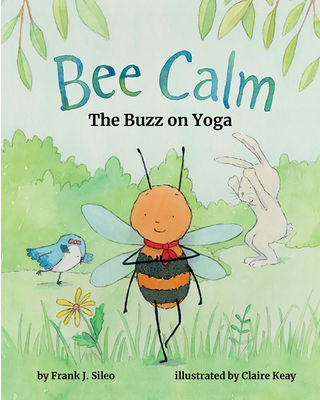Mindfulness
Bee Calm: The Buzz on Yoga
The Book Brigade talks to child psychologist Frank Sileo.
Posted May 9, 2019

Children today often lead over scheduled and overextended lives with high degrees of stress. Yoga may be an ideal way to boost physical fitness while quieting the mind.
What led you to write a book on yoga for children?
I love yoga! Writing this book seemed to be a natural follow-up to my previous book on mindfulness called Bee Still: An Invitation to Meditation. Yoga and meditation are the two formal practices of mindfulness. I wanted to write a book about yoga that would pique children's curiosity about yoga. I use mindfulness in my private practice with my children and adult patients. I am also a practitioner of mindfulness. It's so important in teaching mindfulness to others that you study and cultivate your own practice of mindfulness.
Do kids really need yoga?
Yes! Yoga is mindfulness in motion. Yoga exercises both the body and the mind. It is a fun way for kids to learn to breathe, focus, tune into what they are feeling emotionally and physically. It helps balance the nervous system. In our world, kids (and adults) are constantly on the go go go! The practice of yoga calls us to stop, pause, and notice what is going on with our bodies and minds. There are wonderful physical benefits to the practice of yoga. By doing yoga, kids strengthen their bodies and achieve greater flexibility and balance. The emotional benefits of the practice include a reduction in stress and anxiety, and it builds confidence and self-esteem. With anxiety disorders being so prevalent, yoga is a wonderful intervention for kids.
How do you use yoga in your practice with children?
In my practice, if it's clinically appropriate, I introduce the topic of yoga to patients and couch it as a fun experiment that may help them with their feelings. I am always surprised at how many children, even as young as four, already know about yoga. Many kids are exposed to yoga from their schools. More school systems are implementing mindfulness programs into their curriculums. Sometimes I don't have to teach the poses. The children already know how to do them. Depending on the child and the issue at hand, I may start or end a session with some yoga.
What do the adults in children’s lives need to know about yoga for kids?
Yoga is a wonderful tool and lifestyle practice that kids could benefit from and have fun with. Too often kids are involved in activities that have high demands, stress, and the pressure to win. Yoga is an activity that doesn't have the distractions of cheering fans in stands or other noises that are often found in kid-related activities. Yoga is a peaceful activity, a solitary one even though it can be practiced in a group setting. As we know, yoga is a physical activity, so parents should make sure that their children are doing the poses correctly and not pushing or hurting themselves in some way. For example, one mistake I encounter often with kids (and adults) is when they do Tree pose. Kids will often place their foot on their knee. Putting pressure on the knee can cause injury. The foot should be below or above the knee to avoid injury. Parents need to monitor their children when doing yoga. In my book, one of the couplets is, "Yoga should feel good so don't push or strain. Stop what you're doing if you feel any pain."
Is there any research suggesting that yoga has specific benefits for children?
In recent years, much progress has been made in studying yoga and mindfulness for children. A majority of the research has been in the area of implementing yoga in schools. According to the research, yoga and mindfulness have been shown to improve the physical and mental health in children (ages 6 to 12). Researchers found that yoga helps with balance, strength, and endurance. Yoga also provides psychological benefits such as improved focus, attention, memory, self-esteem, and overall academic performance. It can assist in reducing stress and anxiety and improving classroom behavior. More research suggests that yoga can help children with attention deficit hyperactivity disorder (ADHD) by increasing attention and decreasing hyperactive and impulsive behavior. Research is continuing to grow on this topic.
Where does yoga fit in an era when kids need to be encouraged to be active?
Yoga fits very nicely. Yoga is definitely a physical activity that has fitness and health benefits. It is a different way of being active and different from running or dancing. It involves maintaining focus while breathing and moving your body into different poses. It is active but it calls upon us to be still and to hold our bodies in a pose. It can be more active depending on the type of yoga a child chooses to practice. Some styles are more strenuous and active than others. Everyone has to find the style that speaks to their needs and what they are comfortable with.
Do kids and parents really need yoga as a way to enhance their bond?
Kids and parents do not need yoga to enhance their bond—but it couldn't hurt! Yoga can be a fun and wonderful experience when it is practiced together with a parent, parents, or family. As parents, we are children’s role models. We can't just say to our children, "Go and do some yoga." We need to explain to them why it's a helpful practice and what’s in it for them, let them watch us do it, and share our feelings (both good and bad) about doing yoga. Spending time together with our children is the best reward they can ever have and want. Spending time together in a fun activity only can enhance and grow the bonds between us and our children.
Are there specific types of yoga that are good for kids?
There are many styles of yoga. No one type is recommended for kids. I advise parents to do their research and find the style that fits their child's needs and abilities. That includes talking with yoga studios and teachers. I would suggest starting out slowly and gradually building a child's practice of yoga. A child may like Vinyasa yoga where one pose flows into the next. Yin yoga is great for beginners, given its slower pace. There is also Laughter yoga and Goat yoga, which integrates animal-assisted therapy with yoga. Whatever style of yoga your child tries, it should be fun. It’s also possible to mix it up.
Doesn't teaching yoga to kids inherently convey the message that even quiet time has to be a program?
Many kids are overscheduled and overextended. The great thing about yoga is that you don't necessarily need to find a "program" to practice it, nor should it be viewed as another thing to do in an already busy day. I am encouraging children to look at yoga as a mindful pause and break in their lives to take a breath, focus or re-focus their attention to what is going on for them. Yoga actually encourages quiet time and mental exploration. Moreover, you don't need to take your child to a class or studio to practice yoga. It doesn't have to be practiced at a specific time or for a certain amount of time. Children can do it whenever they wish—in the back yard, in their room, on the deck outside. Yoga shouldn't be or become a chore. It should be an activity that they learn, practice, and use in their daily lives. I would suggest observing your child doing yoga in the beginning, to ensure he or she is doing the poses correctly and not hurting him- or herself. Safety first!

In your book, a possum asked why it's standing there, looking up. The sky responds that the possum is really doing yoga—as if standing and looking at the sky is somehow not enough. Isn’t there a need for that, too?
Agreed! Standing and looking at the sky is a great way to shut off the world and let our minds just wander!
About THE AUTHOR SPEAKS: Selected authors, in their own words, reveal the story behind the story. Authors are featured thanks to promotional placement by their publishing houses.
To purchase this book, visit: Bee Calm: The Buzz on Yoga




